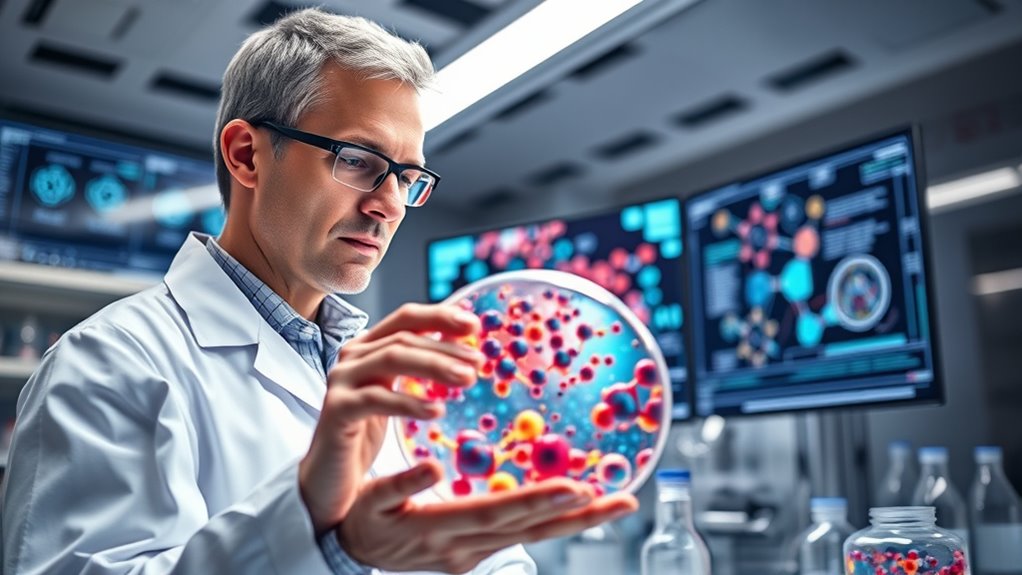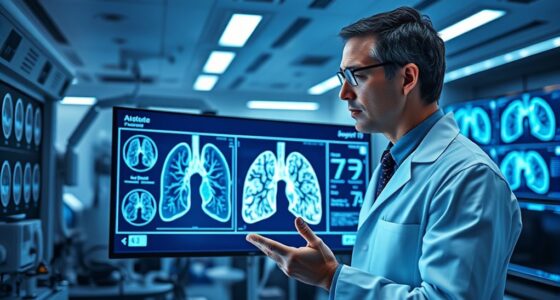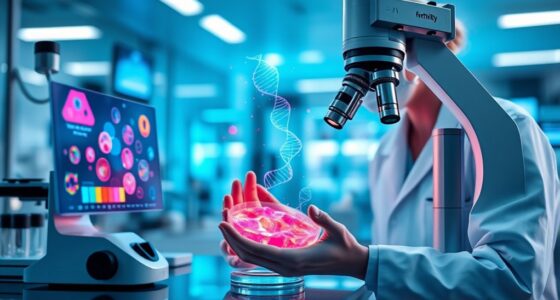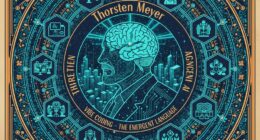A groundbreaking AI-designed drug has quickly moved into human trials, marking a major milestone in pharmaceutical research. By utilizing advanced algorithms, AI speeds up the drug discovery process that traditionally takes years. However, regulatory agencies are adapting their frameworks to guarantee safety and effectiveness before approval. While this rapid progress is promising, ongoing efforts focus on transparency, safety assessments, and ethical considerations. Keep exploring to discover how this innovation might revolutionize future treatments.
Key Takeaways
- An AI-designed drug has successfully advanced to human clinical trials, marking a significant milestone in pharmaceutical research.
- AI accelerates drug discovery by rapidly analyzing datasets, reducing traditional development timelines from years to months.
- Regulatory agencies are updating frameworks and implementing new validation protocols to accommodate AI-driven drug approvals.
- Ensuring safety and reliability involves rigorous assessments and transparency to build trust among stakeholders.
- Human oversight remains essential to address ethical concerns, data bias, and explainability in AI-designed drug development.

Thanks to advances in artificial intelligence, a new drug developed entirely through AI design is now ready to enter human clinical trials. This breakthrough marks a significant milestone in pharmaceutical research, showcasing how AI can accelerate drug discovery processes that traditionally take years. However, as you step into this new era, it’s vital to consider the ethical and regulatory challenges that come with it. AI ethics come into play because the technology makes decisions based on complex algorithms, often without human oversight. You need to ensure the data used to train these models is unbiased and representative, otherwise, you risk perpetuating health disparities or introducing unintended side effects. Transparency becomes crucial—stakeholders, including regulators and patients, must understand how the AI arrived at its drug design. This fosters trust and accountability, especially when human safety is at stake.
On the regulatory front, hurdles are still significant. Existing approval pathways weren’t designed with AI in mind, so agencies like the FDA and EMA are working to adapt their frameworks. You might find that regulatory approval for AI-designed drugs requires new validation protocols, rigorous safety assessments, and ongoing oversight. Navigating these hurdles demands close collaboration between AI developers, pharmaceutical companies, and regulators. You’ll need to demonstrate that the AI process is reliable, repeatable, and capable of identifying potential risks just as thoroughly as traditional methods do. This can slow down the process temporarily, but it’s necessary to ensure that AI’s rapid innovation doesn’t compromise safety standards.
Despite these challenges, the speed at which this AI-designed drug has moved toward human trials is impressive. You’re witnessing a shift where AI’s ability to analyze vast datasets and predict molecular interactions reduces the time spent on trial-and-error experiments. Yet, it’s important to stay vigilant about AI ethics—preventing data bias, ensuring explainability, and maintaining human oversight. As regulators catch up with these technological advances, new policies will emerge to streamline approval processes without sacrificing safety. Your role as a stakeholder involves staying informed and advocating for responsible AI use in medicine. Ultimately, this breakthrough exemplifies how, with careful attention to ethical and regulatory considerations, AI can revolutionize drug development, bringing life-saving treatments to patients faster than ever before.
Frequently Asked Questions
How Does AI Ensure the Safety of New Drug Candidates?
You might wonder how AI guarantees drug safety. It analyzes vast data sets to identify potential side effects while constantly learning to minimize AI bias. It also respects data privacy, using secure methods to handle sensitive information. By predicting adverse reactions early, AI helps create safer drugs faster. However, human oversight remains essential to verify AI findings, ensuring safety before human trials begin.
What Are the Limitations of AI in Drug Discovery?
You should know that AI’s limitations in drug discovery include reliance on quality data, which can be affected by data privacy concerns. Machine learning models may produce biased or inaccurate results if data is incomplete or skewed. Additionally, AI can’t fully replicate complex biological processes or predict unforeseen side effects, meaning human expertise remains essential to verify findings and ensure safety throughout development.
How Does AI Compare to Traditional Drug Development Methods?
You’ll find that AI markedly outpaces traditional methods, reducing drug development from years to months. It leverages computational modeling and data analysis to predict drug behavior faster and more accurately. Unlike manual trial-and-error, AI quickly sifts through vast data, identifying promising compounds early. This accelerates discovery, cuts costs, and increases success rates, making AI a transformative tool that revolutionizes how we develop new medicines efficiently and effectively.
What Ethical Concerns Arise With Ai-Designed Drugs?
You should consider ethical concerns with AI-designed drugs, like algorithm transparency and intellectual property. If algorithms lack transparency, it’s hard to trust how decisions are made, raising safety issues. Additionally, intellectual property rights become complex, as AI may generate novel compounds that challenge existing patents. These issues could impact patient safety, innovation, and fair access, so addressing them is essential before widespread adoption.
How Will AI Impact Drug Pricing and Accessibility?
Price and access are poised to plummet or possibly plateau, depending on how AI impacts the market. You might find drugs becoming more affordable as AI speeds up development, but AI regulatory hurdles and patent challenges could hinder widespread accessibility. If you navigate these issues well, AI could democratize medicine, making treatments more reachable. However, unresolved legal and patent obstacles might also limit the benefits, keeping some drugs out of reach for many.
Conclusion
You can’t ignore how AI is revolutionizing drug development. Just last year, researchers used AI to design a new drug in just 60 days, a process that used to take years. Now, with this AI-designed drug moving to human trials in record time, it’s clear that technology is accelerating breakthroughs. This rapid pace could mean faster access to life-saving treatments, transforming healthcare as we understand it. The future of medicine is happening now—are you ready for it?











